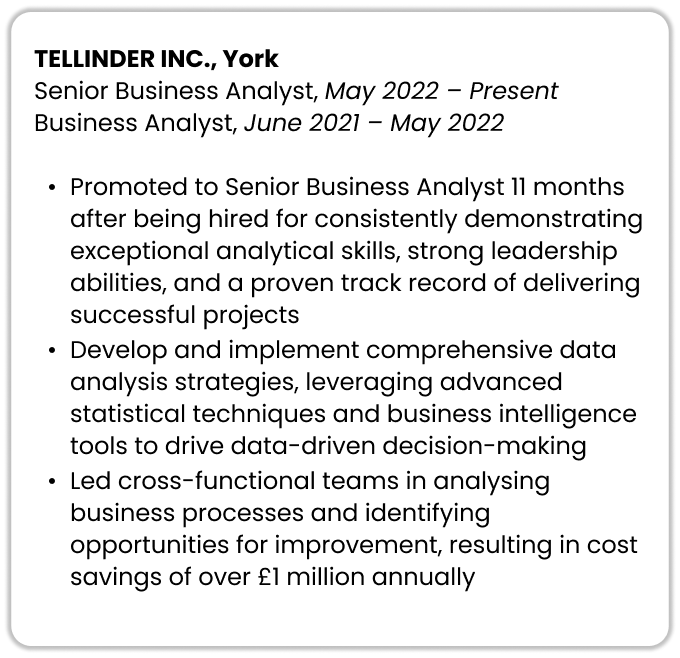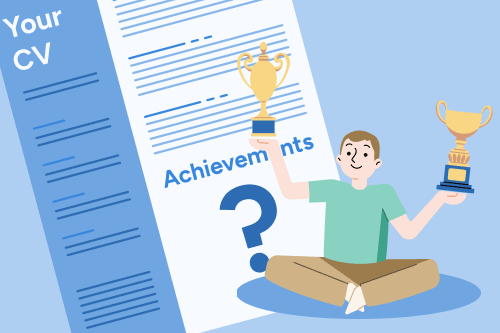Having promotions on your CV can give you an edge over other job applicants.
But the way you should show your career progression in your CV’s work experience section depends on the types of promotions you’ve received. So here’s how to show a promotion on your CV when:
- your promotion changed your duties
- your promotion didn’t change your responsibilities much
- you returned to a company with a different job title
1. When your promotion changed your duties
If your promotion resulted in significant changes to what you do at work, then you need to highlight the differences on your CV. Showing how your role changes emphasises your versatility to employers. This is how to do it:
Underneath your job entry header (company name and location), write your job titles and the dates you held them, starting with the most recent and working backwards. Then write a few bullets explaining your duties and results under each job title.
To ensure the employer sees that you were promoted, you can also explain the reason you were promoted in the first bullet under your first job title, like so:
Promotion on CV example (copy & paste text version)
Company Name, Location
Current or most recent Job Title, Month Year – Month Year
- Reason you were promoted (e.g., ‘Promoted to Advanced Specialist in April 2023 due to meeting or exceeding KPI in each quarter since I was hired’)
- Main duty and top accomplishments while performing it
- Next most important responsibility and top achievements
- Etc.
Previous Job Title, Month Year – Month Year
- Main duty and top accomplishments while performing it
- Next most important responsibility and top achievements
- Etc.
Also follow the example above to highlight a lateral move at the same company on your CV.
A lateral move is a move from one job to another at the same level. Typically, this type of move happens when you take a job at a new company. But if you moved to a new role without getting bumped up to a new level, that’s a lateral move that shows your adaptability.
You can also talk about the achievements that led to your promotion when you create your cover letter. You can go into more depth about exactly what impressed your superiors.
2. When your promotion didn’t change your responsibilities much
Did you progress to a more advanced version of your job (e.g., from Researcher to Senior Researcher)?
You don’t need to make separate lists of responsibilities for your job titles when you write your CV in this situation, because your bullets would become repetitive. Repetition wastes space on your CV and makes you seem less accomplished to employers.
So, in your work experience entry, just stack the most recent title on top of the older one, each with the dates you held them. Then write a bullet to explain why you were promoted, followed by 2–4 more bullet points detailing your accomplishments from both roles.
Here’s this CV writing tip in action:
Promotion on CV example (copy & paste text version)
Company Name, Location
Current or most recent Job Title, Month Year – Month Year
Previous Job Title, Month Year – Month Year
- Reason you were promoted (e.g., ‘Promoted to Advanced Specialist in April 2023 due to meeting or exceeding KPI in each quarter since I was hired’)
- Main duty and top accomplishments while performing it
- Next most important responsibility and top achievements
- Etc.
Showcase your promotion using a CV template that catches employers’ attention.
But if you do have different duties and achievements to highlight on your CV for your different roles within the same company, do make multiple lists. The next section covers how to do that:
3. When you returned to a company with a different job title
Did your previous company bring you back in a more senior capacity? This is how to show that on your CV in a way that clearly outlines your career progress:
This is how a promotion that took you back to a previous employer should look on your CV:
Promotion on CV example (copy & paste text version)
New Job Title
Company A Name, Location | Month Year – Month Year
- Main duty and top accomplishments while performing it
- Next most important responsibility and top achievements
- Etc.
Job Title
Company B Name, Location | Month Year – Month Year
- Main duty and top accomplishments while performing it
- Next most important responsibility and top achievements
- Etc.
Previous Job Title
Company A Name, Location | Month Year – Month Year
- Main duty and top accomplishments while performing it
- Next most important responsibility and top achievements
- Etc.
Don’t have much time to add your promotion to your CV? Find a good CV maker online that does the writing and formatting for you, so you can quickly get your job application submitted.








